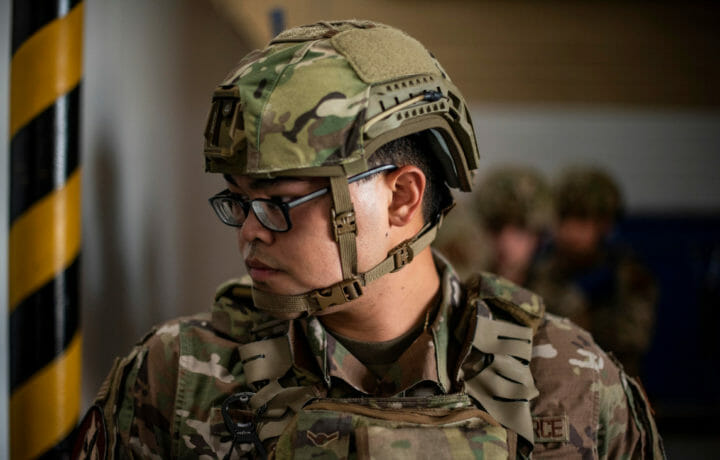Helmets have been used by soldiers since antiquity, while the modern combat helmet was introduced during the First World War. The purpose at the time was to primarily provide protection from low velocity threats such as artillery shrapnel, but in the Cold War, the emphasis was on providing ballistic protection from high velocity small arms. In recent years, there have also been efforts to not only stop these impacts, but to also help protect wearers from concussions and other brain injuries.
No helmet is perfect, in part because with steel materials, it was found that to successfully stop most small arms fire would require a helmet that was too heavy to be worn for extended times. Even with evolution of materials such as Kevlar, comfort is still important. The most effective helmet at addressing threats to the wearer is useless if he takes it off his head!
Balancing all of these factors has been tricky, but now researchers at Rice University have received a $1.3 million grant from the Office of Naval Research through the Defense Research University Instrumentation Program to create the world’s first printable military “smart helmet” using industrial-grade 3D printers.
3D Printed
The production of helmets has long been a complex issue as well. For eons skilled workers made helmets by hand, but that changed following the industrial revolution. Yet, even with dies and presses it took several steps and large teams to make the steel helmets.
The process to make modern Kevlar and similar helmets has also been a complex and expensive proposition. The Rice University effort could result in helmets that could be produced at a cheaper cost and be more customized to the wearer.
Led by principal investigator Paul Cherukuri, executive director of Rice’s Institute of Biosciences and Bioengineering, the Smart Helmet program seeks to modernize the standard-issue military helmet through the use of 3D-printing or “additive manufacturing.” This would also utilize a nanomaterial-enhanced exoskeleton with embedded sensors to actively protect the brain against kinetic or directed-energy effects.
The team at Rice will use Carbon Inc.’s L1 printer to develop a strong-but-light military-grade helmet that incorporates advances in materials, image processing, artificial intelligence, haptic feedback and energy storage. This could also take advantage of additive manufacturing’s ability to enable rapid prototyping that in turn simplifies the process of incorporating the sensors, cameras, batteries and wiring harnesses the program requires.
“Current helmets have evolved little since the last century and are still heavy, bulky, passive devices,” Cherukuri said in a statement. “Because of advances in sensors and additive manufacturing, we’re now reimagining the helmet as a 3D-printed, AI-enabled, ‘always-on’ wearable that detects threats near or far and is capable of launching countermeasures to protect soldiers, sailors, airmen and Marines. Essentially, we’re building J.A.R.V.I.S.”
FlatCam System in Helmet
Rice University’s Smart Helmet program will draw on technology from other projects, notably the FlatCam, a system developed by co-investigator and electrical and computer engineer Ashok Veeraraghavan and his colleagues. It incorporates sophisticated image processing to eliminate the need for bulky lenses. Additionally, Cherukuri’s own Teslaphoresis, which has been described as a tractor beam for nanomaterials, could be used help create the physical and electromagnetic shields within the helmets.
“A smart helmet task force has been assembled from some of the finest minds at Rice to tackle the challenge of creating a self-contained, intelligent system that protects the warfighter at all times,” Cherukuri added. “We’ve got a lot of innovative tech in university labs that has never seen the light of day. We’re simply developing that technology into a device that gives the men and women protecting our country a real chance at coming home safe and sound.”
DEVCOM-SC Helmet
The Rice University effort is not the only one engaging in the development of a 3D helmet for the military. General Lattice has designed software that could be used by the U.S. Army’s Development Command Soldier Center (DEVCOM-SC) to produce lattices for combat helmets.
The company, which develops software for designing optimal lattice structures that can be fabricated via 3D printing, is reported to be involved in research project with DEVCOM, All Points Logistics, and 3D print service GoProto. The partners are now engaged in a one-year research and development project at General Lattice’s facility in Chicago, Illinois, while possible 3D printers, materials and desired performance characteristics for producing the helmet’s suspension system and impact absorption have also been chosen.
Researchers in the DEVCOM Soldier Center Helmet Laboratory have already spent the past decade working to optimize combat helmet performance by developing new modeling, design and processing techniques. Combat helmets are comprised of flat sheets of ballistic material pre-formed into a helmet shape and then processed at a high temperature and pressure. Wrinkling and folds occur as the flat fabric conforms to the three-dimensional shape. Those seams, wrinkles, and folds in the materials can seriously degrade the ballistic performance, requiring more material and more mass to protect against a given threat, but 3D printing could change this process and result in a helmet that provides great protection and comfort.
“The capabilities of traditional foam material have been exhausted, and General Lattice is engineering and authenticating its replacement using 3D printing and advanced lattice geometries,” General Lattice has said via a statement. “The state-of-the-art lattice materials designed by the company are unattainable through conventional composites and manufacturing technologies. These generated lattice materials will interact with real-world environment testing to accurately validate key performance requirements as defined by the DEVCOM-SC. This is to enhance soldier protection and survivability for the warfighter.”




